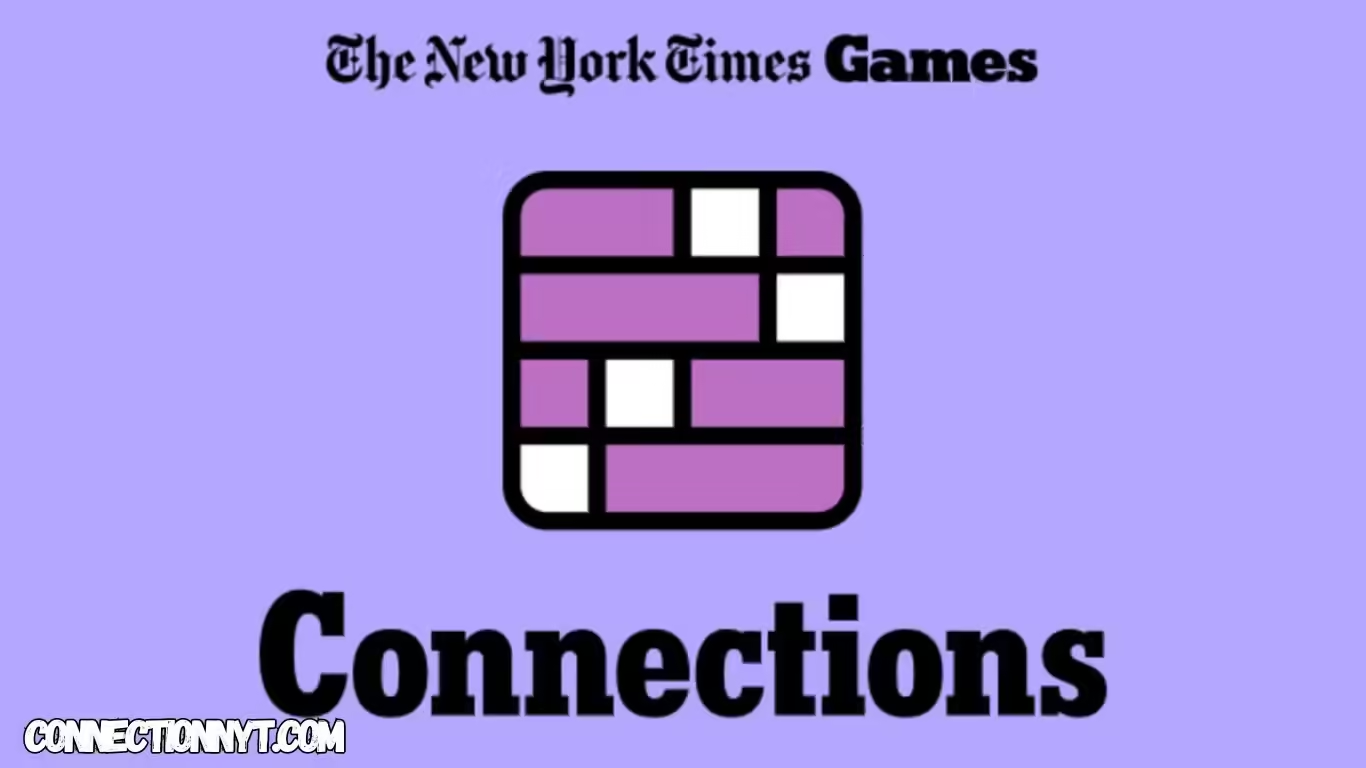Connections NYT Answers: Your Ultimate Guide to Solving Puzzles (2024)
Discover how to master Connections NYT with this comprehensive guide. Learn tips, strategies, and get answers to July 10’s puzzle.
Table of Contents
Introduction
What is NYT Connections? NYT Connections is one of the most engaging and challenging word puzzles offered by The New York Times. It has quickly become a favorite among puzzle enthusiasts due to its unique format, requiring players to group words into specific categories. Each puzzle provides a grid of 16 words, and the objective is to find the four groups of four related words. As simple as it sounds, the game demands critical thinking and a keen eye for patterns.
The Popularity of Connections in the New York Times Since its introduction, NYT Connections has gained massive popularity. Puzzle lovers from around the world appreciate the game for its mix of simplicity and complexity. The game’s increasing difficulty and daily fresh puzzles keep the player base engaged, making it a staple for those looking to exercise their cognitive skills.
Overview of NYT Puzzle Games The New York Times has a rich history of offering high-quality puzzle games. From crosswords to Spelling Bee, NYT has consistently provided challenging and enjoyable games for decades. Connections is the latest addition, and it fits perfectly into the NYT puzzle family, adding a fresh twist to word games.
How to Play Connections NYT
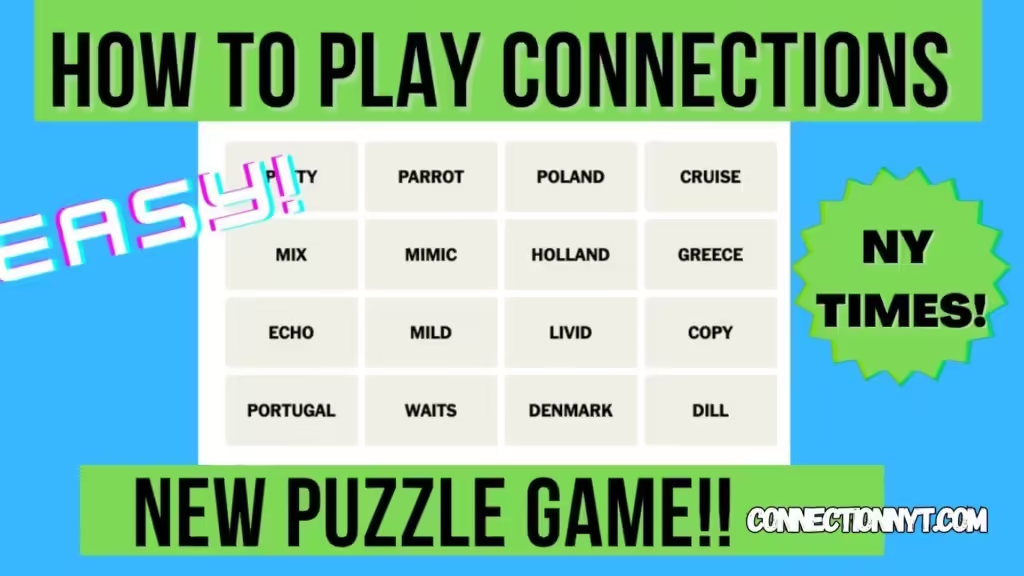
Step-by-Step Guide to Playing Connections Playing Connections is straightforward, but mastering it requires practice. Start by carefully examining the 16 words presented. The goal is to identify four groups of four words that share a common theme or connection.
Understanding the Game’s Objective The primary objective is to group the words into categories. Each group shares a hidden connection, which could be anything from synonyms, antonyms, or even thematic links like colors or animals.
Basic Rules and Guidelines
- Select four words that you believe are connected.
- If correct, the group is removed from the grid.
- If incorrect, you’ll receive a strike. Three strikes end the game.
- Continue until all words are grouped correctly.
Navigating the Interface The game’s interface is user-friendly. Words are presented in a grid, and selecting them is as easy as clicking. Hints are available if you’re stuck, but using them will affect your final score.
Tips for Beginners
- Start with the most obvious connections.
- Pay attention to word endings or prefixes.
- Use the process of elimination if you’re unsure.
The Groups in NYT Connections
What Are the Groups in Connections? Groups in Connections are categories that the game’s words fit into. These categories can be based on various themes such as emotions, professions, or objects.
Types of Groups: Themes and Categories Common themes include:
- Colors: Words like “Red,” “Blue,” “Green,” and “Yellow.”
- Professions: Words like “Doctor,” “Engineer,” “Teacher,” and “Lawyer.”
Examples of Common Groupings
- Synonyms: Words that mean the same thing.
- Antonyms: Words that have opposite meanings.
- Thematic Links: Words related by theme, such as holiday-related words.
How to Identify Group Connections To identify group connections, look for patterns or commonalities among the words. Sometimes, the connection might be based on word structure, while other times, it’s purely thematic.
Difficulty Levels in NYT Connections
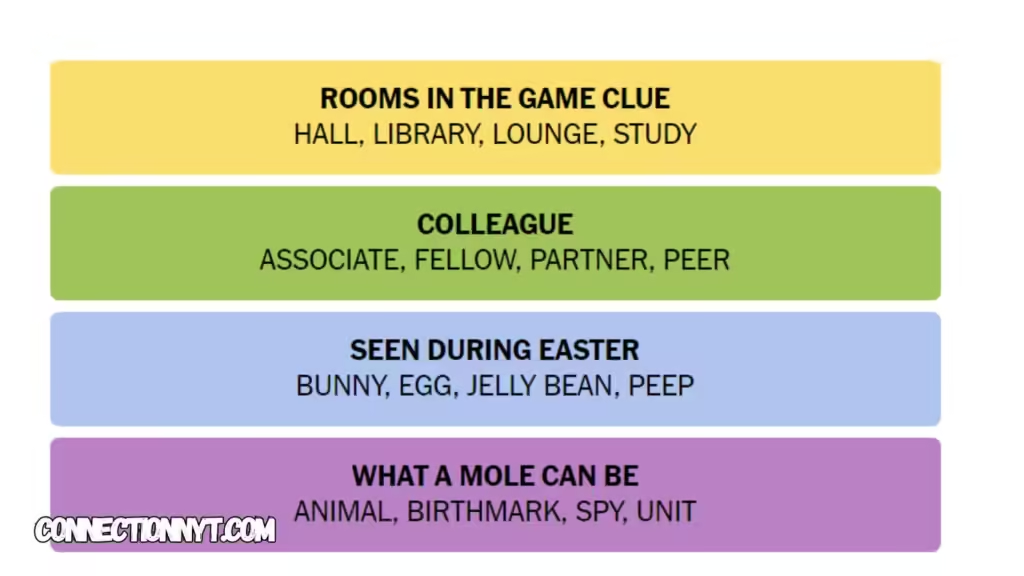
Is NYT Connections Hard? The difficulty of NYT Connections can vary depending on the day’s puzzle. Some puzzles are straightforward, while others can be incredibly challenging, requiring lateral thinking.
Factors Affecting Game Difficulty
- Word Familiarity: Difficulty increases if the words are less common or have multiple meanings.
- Theme Obscurity: The more obscure the connection, the harder it is to spot.
- Level Progression: Puzzles tend to get harder as you progress.
Easy, Medium, and Hard Levels Explained NYT Connections offers puzzles at varying difficulty levels:
- Easy: Obvious connections and common words.
- Medium: Requires some thought but still accessible.
- Hard: Involves obscure connections and tricky word play.
Tips for Tackling Difficult Levels
- Take your time and revisit words that don’t immediately make sense.
- Look for less obvious connections, such as word structure or less common themes.
- Use hints strategically if you’re stuck.
User Experiences and Feedback Many players report that while the game is challenging, it’s also incredibly rewarding. The sense of accomplishment when solving a particularly tough puzzle keeps players coming back.
Creation of NYT Connections
Who Makes NYT Connections? NYT Connections puzzles are crafted by a team of skilled puzzle creators at The New York Times. These creators are experts in language and game design, ensuring that each puzzle is both challenging and fair.
Behind the Scenes: The Puzzle-Making Process The process involves brainstorming word lists, testing connections, and refining the puzzles to ensure they’re both solvable and engaging.
Interviews with NYT Puzzle Creators Interviews with puzzle creators reveal the thought process behind crafting each puzzle. They aim to balance difficulty while ensuring that the puzzles remain fun and accessible.
The Role of Feedback in Puzzle Creation Player feedback is crucial in refining the puzzles. The creators often tweak future puzzles based on how players interact with current ones, ensuring that the game evolves over time.
Analysis of Specific NYT Connections
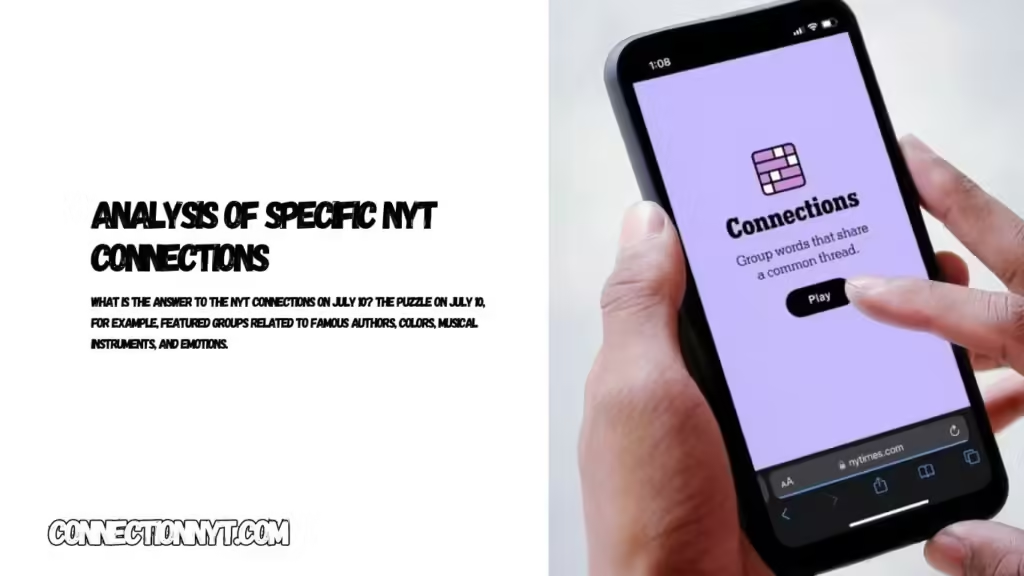
What is the Answer to the NYT Connections on July 10? The puzzle on July 10, for example, featured groups related to famous authors, colors, musical instruments, and emotions.
Breakdown and Explanation of the Puzzle Each group was carefully selected to challenge different aspects of the player’s knowledge and word association skills.
Strategies Used in Solving Many players found that starting with the most obvious group (e.g., colors) made the puzzle easier to tackle. The strategy involved identifying the simplest group first, then using a process of elimination.
Learning from Previous Puzzles Analyzing past puzzles can improve future performance. Noticing recurring themes or word patterns can provide an advantage.
Key Features of NYT Connections
What Are the 4 Connections? The “4 Connections” refers to the four groups you need to identify in each puzzle. Each group must consist of four related words.
Understanding the Concept of Connections Connections can be based on literal meanings, wordplay, or thematic links. Understanding this variety is key to mastering the game.
Examples of 4-Group Connections
- Seasons: Spring, Summer, Fall, Winter.
- Directions: North, South, East, West.
How Connections Evolve Over Time As you progress, the connections in the puzzles become more complex, challenging your understanding and pushing your cognitive limits.
Levels of Connections in NYT
What Are the Levels of Connections in NYT? The game features different levels, each with its own set of challenges. As you advance, the puzzles increase in complexity.
Explanation of Different Levels
- Beginner: Simple connections with straightforward categories.
- Intermediate: Requires a deeper understanding of word relationships.
- Advanced: Involves abstract connections and tricky wordplay.
Progression Through Levels Progression is achieved by successfully completing puzzles. Each level unlocks new challenges and rewards.
Rewards and Achievements Completing levels earns you badges and achievements, adding a layer of gamification to the experience.
Color Codes in NYT Connections
What Do the Colors Mean in NYT Connections? The color-coding system helps you identify which groups have been correctly or incorrectly identified.
Color Coding System Explained
- Green: Correct group identified.
- Yellow: Incorrect attempt, but a potential correct group.
- Red: Incorrect and no match.
How Colors Help in Group Identification Colors serve as a guide, helping you track your progress and focus on remaining words.
Common Mistakes with Color Interpretation Misinterpreting colors can lead to confusion. It’s important to understand the color system to avoid unnecessary strikes.
Timing and Availability
What Time Does the NYT Connection Come Out? New puzzles are released daily at midnight Eastern Time. This consistency allows players to incorporate the game into their daily routine.
Release Schedule The daily release keeps the game fresh and provides players with something to look forward to each day.
How to Access New Puzzles Puzzles are accessible through The New York Times website or app. Subscription may be required for full access.
Managing Puzzle Notifications Setting up notifications ensures that you don’t miss a new puzzle. This can be done through the app settings.
User Experiences and Community
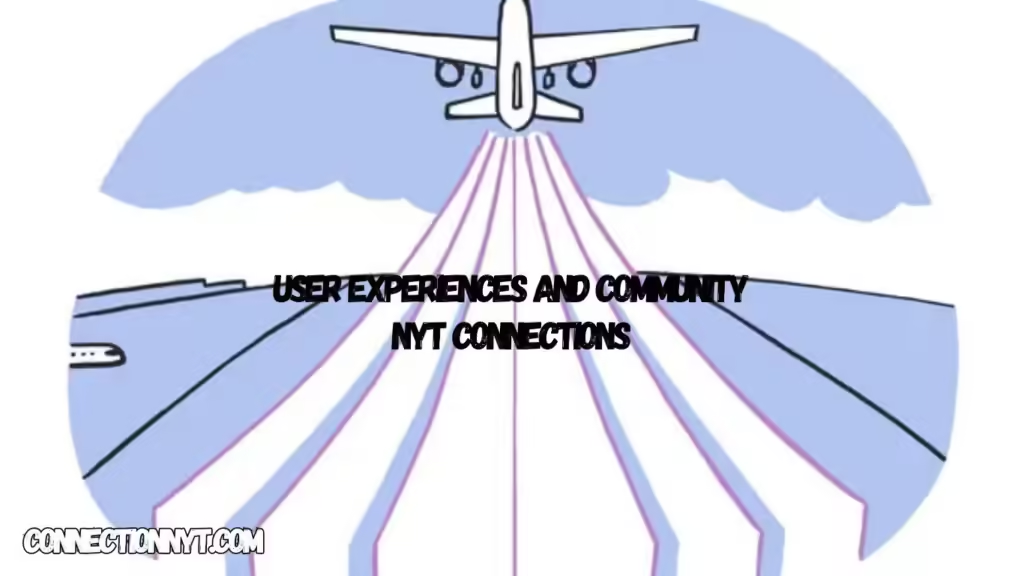
The NYT Connections Community A vibrant community of players has formed around NYT Connections. Forums, social media groups, and online discussions allow players to share tips, strategies, and experiences.
User Reviews and Ratings User feedback is overwhelmingly positive, with many praising the game’s balance of difficulty and fun.
Online Forums and Discussions Forums are a great place to find tips and strategies. Engaging with the community can enhance your gameplay experience.
Tips from Experienced Players Experienced players often share insights that can help newcomers improve their skills. Learning from others is a key part of the game’s appeal.
Sharing Puzzle Strategies Players frequently share their strategies for tackling difficult puzzles, offering a collaborative approach to problem-solving.
Conclusion
Summary of NYT Connections NYT Connections is more than just a word game; it’s a mental workout that sharpens your cognitive skills while providing endless entertainment. The game’s combination of simplicity and complexity makes it accessible yet challenging for players of all levels.
Why NYT Connections Is Worth Trying Whether you’re a puzzle enthusiast or a casual gamer, NYT Connections offers something for everyone. Its daily challenges, coupled with a supportive community, make it a game worth exploring.
Encouragement to Engage with the NYT Puzzle Community Joining the NYT Connections community can enhance your experience. Sharing strategies, discussing puzzles, and learning from others can transform this solo game into a communal activity.
